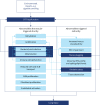Cystic fibrosis transmembrane conductance regulator in COPD: a role in respiratory epithelium and beyond
- PMID: 37003609
- PMCID: PMC10066568
- DOI: 10.1183/13993003.01307-2022
Cystic fibrosis transmembrane conductance regulator in COPD: a role in respiratory epithelium and beyond
Abstract
The cystic fibrosis transmembrane conductance regulator (CFTR) is a crucial ion channel for transport of chloride and bicarbonate anions. Functional roles of CFTR have been identified in a broad range of cell types including epithelial, endothelial, immune and structural cells. While CFTR has been investigated largely in the context of inborn dysfunction in cystic fibrosis, recent evidence shows that CFTR is also affected by acquired dysfunction in COPD. In patients with COPD and smokers, CFTR impairment has been demonstrated in the upper and lower airways, sweat glands and intestines, suggesting both pulmonary and systemic defects. Cigarette smoke, a key factor in COPD development, is the major cause of acquired CFTR dysfunction. Inflammation, bacterial byproducts and reactive oxygen species can further impair CFTR expression and function. CFTR dysfunction could contribute directly to disease manifestation and progression of COPD including disturbed airway surface liquid homeostasis, airway mucus obstruction, pathogen colonisation and inflammation. Mucus plugging and neutrophilic inflammation contribute to tissue destruction, development of dysfunction at the level of the small airways and COPD progression. Acquired CFTR dysfunction in extrapulmonary organs could add to common comorbidities and the disease burden. This review explores how CFTR dysfunction may be acquired and its potential effects on patients with COPD, particularly those with chronic bronchitis. The development of CFTR potentiators and the probable benefits of CFTR potentiation to improve tissue homeostasis, reduce inflammation, improve host defence and potentially reduce remodelling in the lungs will be discussed.
Copyright ©The authors 2023.
Conflict of interest statement
Conflict of interest: M.A. Mall declares editorial support from Novartis Pharma AG since the initial planning of the work, and declares grants from German Ministry for Education and Research and the German Research Foundation, consulting fees from Abbvie, Antabio, Boehringer Ingelheim, Enterprise Therapeutics, Kither Biotech, Pieris Pharmaceuticals, Santhera, Sterna Biologicals and Vertex Paharmaceuticals, lecture fees from Arrowhead Pharmaceuticals, Boehringer Ingelheim and Vertex Pharmaceuticals, travel reimbursement from Boehringer Ingelheim and Vertex Pharmaceuticals, and personal fees for participation on advisory boards from Boehringer Ingelheim, Arrowhead Pharmaceuticals, Vertex Pharmaceuticals, Santhera, Enterprise Therapeutics, Antabio, Kither Biotech and Abbvie; until 2020, M.A. Mall was also an elected unpaid member of the ECFS board. G.J. Criner has no declarations. In the past 36 months, M. Miravitlles has received consulting fees from AstraZeneca, Atriva Therapeutics, Boehringer Ingelheim, Chiesi, GlaxoSmithKline, Bial, Gebro Pharma, CSL Behring, Inhibrx, Laboratorios Esteve, Ferrer, Mereo Biopharma, Verona Pharma, Spin Therapeutics, ONO Pharma, pH Pharma, Palobiofarma SL, Takeda, Novartis, Sanofi and Grifols, speaker fees from AstraZeneca, GlaxoSmithKline, Boehringer Ingelheim, Chiesi, Cipla, Menarini, Rovi, Bial, Sandoz, Zambon, CSL Behring, Grifols and Novartis, support for attending meetings/travel from Novartis, Boehringer Ingelheim and Menarini, research grants from Grifols, and has participated on a data safety monitoring board for Mereo. S.M. Rowe declares grant support for clinical trials conducted through university grants/contracts, consulting services on the design and conduct of clinical trials and support for travel to attend meetings from Novartis; support for clinical trials conduct through university grants/contracts, consulting services on the design and conduct of clinical trials, support for travel to attend meetings, co-chair of the Next Generation Steering Committee and providing research product for investigator initiated research from Vertex; grant support for clinical trials conducted through university grants/contracts, consulting services on the design and conduct of clinical trials, material transfer agreements (MTAs) for investigator-initiated and externally funded research efforts from Galapagos/Abbvie since the initial planning of the work; grant support for clinical trials conducted through university grants/contracts from Bayer, TranslateBio and Proteostasis; research grants through university grants/contracts from Synedgen/Synspira; research contract through university grants/contracts from Celtaxsys, Arrowhead, Ionis and AstraZeneca; research contract through university grants/contracts from Eloxx; declares consulting services on the design and conduct of clinical trials from Bayer, Renovion, Arrowhead, Ionis, Cystetic Medicines, Arcturus and Synedgen/Synspira, including stock options for Synedgen/Synspira within the past 36 months; receipt of research products for investigator initiated research from Renovion; MTA agreements for research efforts from Proteostasis; MTAs for investigator-initiated and externally funded research efforts from Ionis, Galapagos/Abbvie and Synedgen/Synspira; all in the past 36 months; and declares six patents. C.F. Vogelmeier declares institution grants from German Ministry of Education and Science (BMBF), AstraZeneca, Boehringer Ingelheim, Chiesi, CSL Behring, GlaxoSmithKline, Grifols and Novartis, consulting fees from Aerogen, AstraZeneca, Boehringer Ingelheim, CSL Behring, Chiesi, GlaxoSmithKline, Insmed, Menarini, Novartis and Nuvaira, and payment or honoraria for lectures, presentations, speakers bureaus, manuscript writing or educational events from Aerogen, AstraZeneca, Boehringer Ingelheim, CSL Behring, Chiesi, GlaxoSmithKline, Insmed, Menarini and Novartis, in the past 36 months. D.J. Rowlands is an employee of Novartis Pharma AG and retains Novartis stock. M. Schoenberger is a full-time employee of Novartis Pharma AG and retains Novartis stock. P. Altman is a full-time employee of Novartis Pharmaceutical Corporation.
Figures




References
Publication types
MeSH terms
Substances
Grants and funding
LinkOut - more resources
Full Text Sources
Other Literature Sources
Medical
